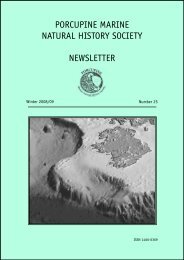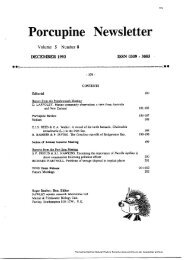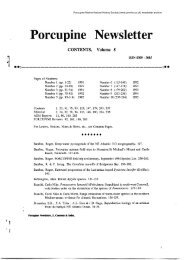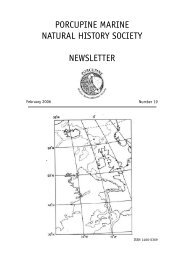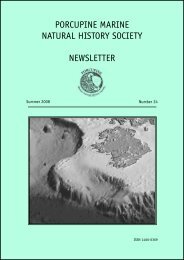Porcupine Newsletter Volume 1, Number 10, August 1980.
Porcupine Newsletter Volume 1, Number 10, August 1980.
Porcupine Newsletter Volume 1, Number 10, August 1980.
You also want an ePaper? Increase the reach of your titles
YUMPU automatically turns print PDFs into web optimized ePapers that Google loves.
188<br />
BOOK REVIEW<br />
John W. Murray, 1979. British nearshore Foraminiferids. Synopses of the<br />
British Fauna (New Series) No.16. Linnean Society of London. pp68. £2.80<br />
This book gives a clear exposition of 63 species of British estuarine and<br />
nearshore foraminiferids. Designed for those who have no prior knowledge of<br />
the group, it covers general features of morphology, biology and ecology,<br />
the collection of samples, their preservation and preparation. A glossary<br />
of terms, the order of classification and a key to genera are given. Descriptions<br />
of species are short, line drawings clear, and a flattering lack<br />
of difficulty was found in identifying species described in the book. It<br />
was, however, disconcerting to conclude that from samples of littoral algae<br />
taken for investigation of other animals, about <strong>10</strong>% of the foraminiferid forms<br />
(especially, it must be admitted, found as dead tests) could not be identified.<br />
To this ignorant reviewer they appeared so different as to be different taxa<br />
not included in this book. That said, the book is welcomed for its useful and<br />
encouraging introduction to a group which forms an important part of many<br />
ecosystems but which is all too often ignored.<br />
Shelagh M.<br />
Smith<br />
The Conchological Society of Great Britain and Ireland have published in<br />
February 1980 as the first of an occasional series of Special Publications<br />
"Marine Mollusca described by John Gwyn Jeffreys with the location of the<br />
type material", by Anders war&. This comprises 60 pages and 8 plates,<br />
including a portrait of Jeffreys.<br />
In his Introduction war& admits that the impetus to compile this work was<br />
brought on by years of frustration in attempting to understand Jeffreys'<br />
species, a sentiment which will surely be echoed by anyone who has worked on<br />
the marine Mollusca of the NE Atlantic and Mediterranean. The author, after<br />
several months' study of the Jeffreys material in the collections of the<br />
U.S. National Museum, Washington cind the British Museum (Natural History),<br />
London has made a survey of all the species of marine molluscs described by<br />
Jeffreys. His aim is to facilitate future study of the species and to obviate<br />
mistakes in designations of type specimens. Wisely he has not attempted to<br />
undertake taxonomic revisions except in those cases where he himself is<br />
preparing a revision of the group. In general, only undoubted holotypes or<br />
lectotypes are figured in order not to limit the taxonomic freedom of subsequent<br />
workers.<br />
The list of species, with accompanying data on type locality, number and<br />
nature of types, museum registration numbers, and remarks, is arranged alphabetically<br />
within a systematic arrangement of families. war& also includes a<br />
list of generic names introduced by Jeffreys, a short biography, a very<br />
extensive bibliography, a list of authors of which there is type material in<br />
the Jeffreys collection, and a very useful list of expeditions, the Mollusca<br />
of which were worked up by Jeffreys, in most cases with full station lists.<br />
A number of lectotypes are designated (all listed in the Abstract), three neotypes<br />
are established and, in general, war& has endeavoured to indicate<br />
whether any particular specific name is valid or invalid. As the author has<br />
not been able to read every word of Jeffreys' 200 papers there must inevitably<br />
be a few omissions, but the work is authoritative and war& is to be complimented<br />
on the thoroughness with which he has accomplished his aim of making<br />
more accessible the finest collection of Palaearctic marine molluscs ever<br />
assembled by one man.<br />
David Heppell<br />
<strong>Porcupine</strong> Marine Natural History Society (www.pmnhs.co.uk) newsletter archive



